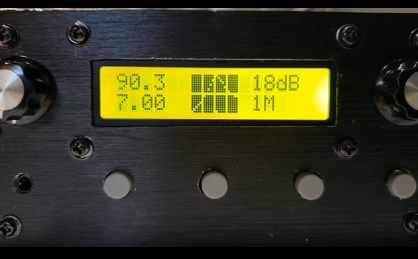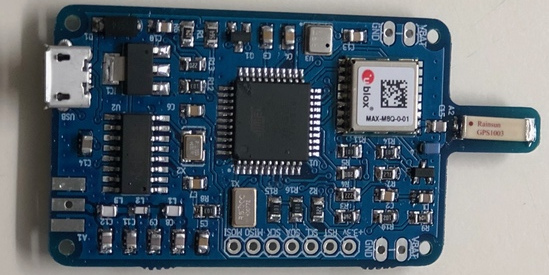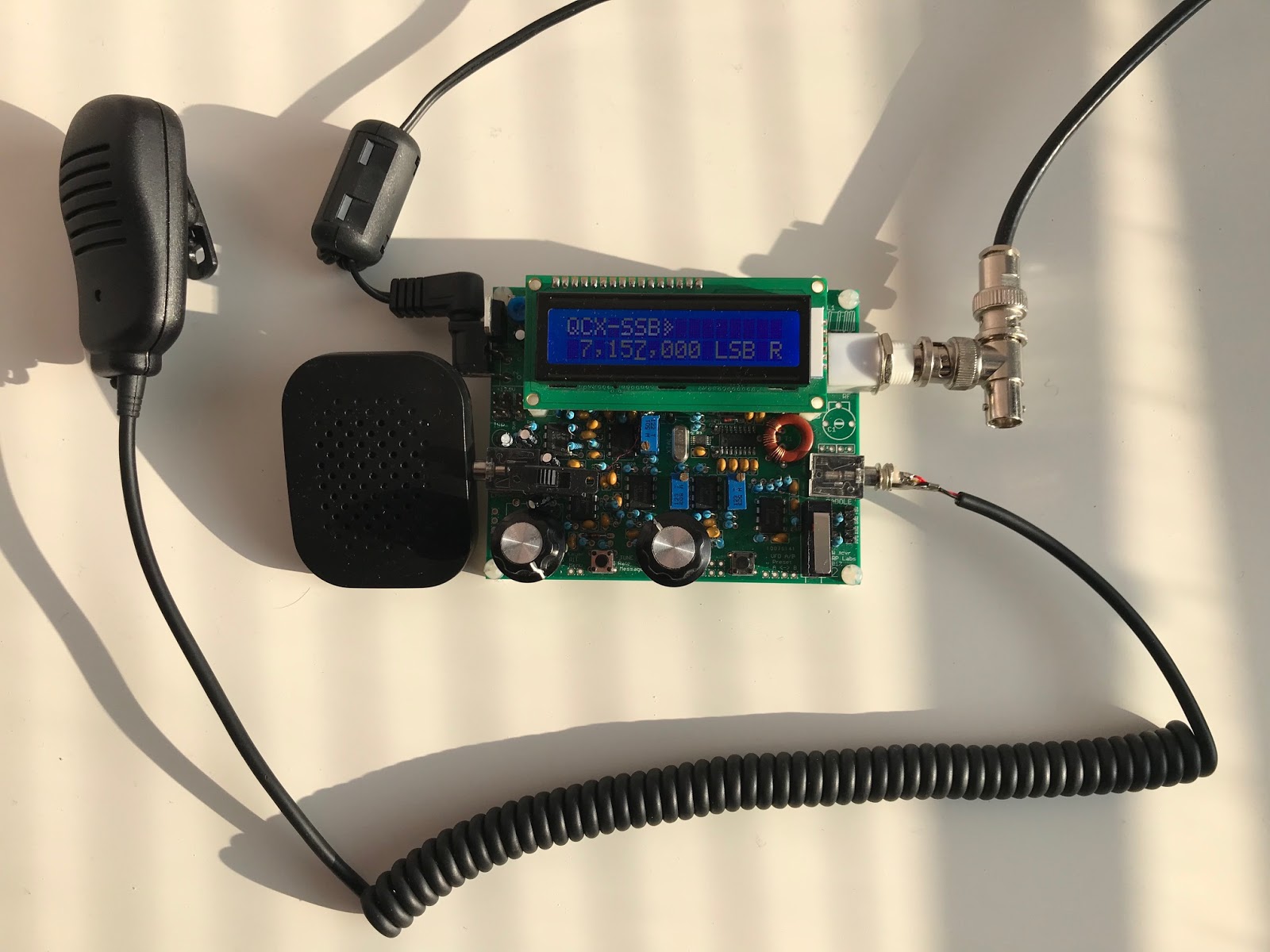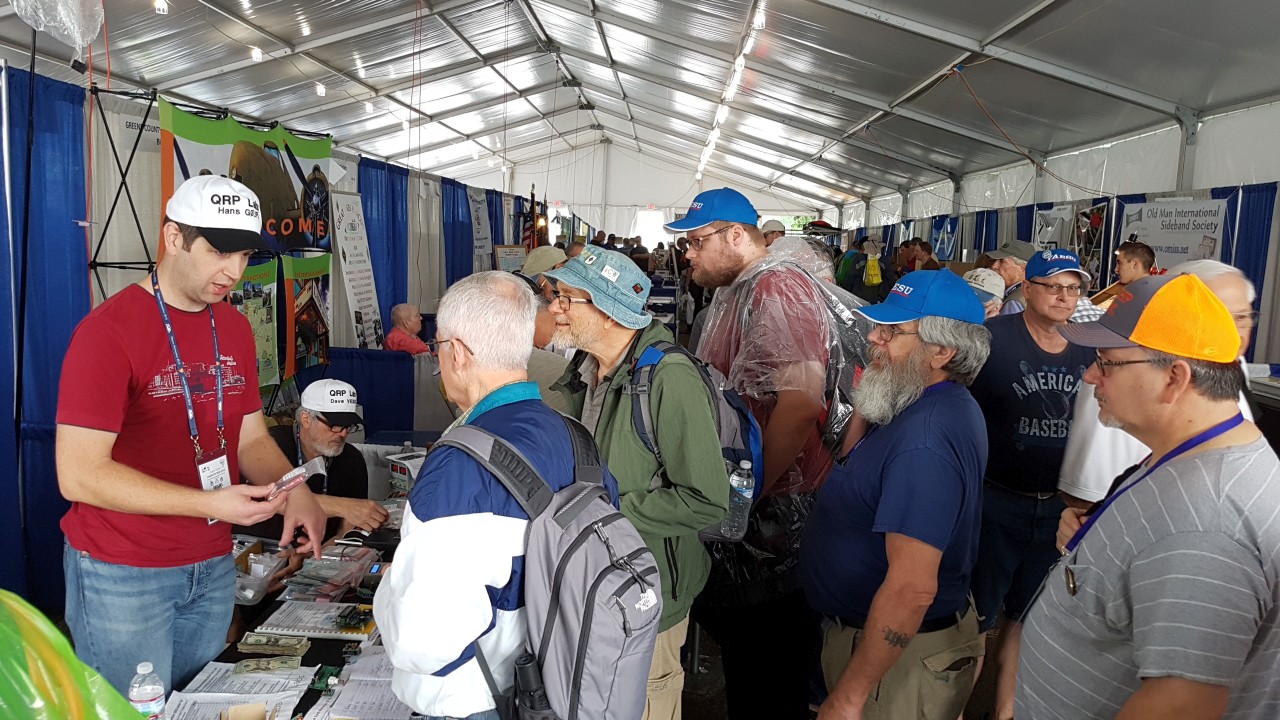0. Newsletters: so rare!
1. QRP Labs at Dayton FDIM, Seminar and Hamvention, 16-19th May
2. QSX update
3. QCX QSO Party, last Monday of every month
4. New product: LightAPRS tracker, by Mustafa TA2MUN and Hakki TA9OHC
5. QCX kit update: changes to kits shipped after 12-Apr-2019
6. QCX kit: firmware version T1.00g released
7. QCX enclosure still stocked by BaMaTech
8. QCX WSPR Tcvr by Maxwell W3LLA
9. QCX SSB transceiver by Guido PE1NNZ
10. Balloon flights update: VE3KCL's record-breaking U3B25 flight
11. Social media, Feedback, unsubscribing
0. Newsletters: so rare!
First and foremost, so important that it is item #0, come my apologies for the scarcity of the "monthly" newsletter. I am painfully aware that the last one was in November 2018 but there has been a lot going on here. My health is now fine: six months of a lot of bronchitis, a little bit of pneumonia, a big vitamin D deficiency, but it is over now and all is well. There were many things to catch up on, and of course the QSX transceiver kit development which is a huge and overdue project. Every day there are hundreds of emails, QRP Labs sales continue to grow relentlessly, and a proportion of the customers have issues that need resolving etc. It all takes a lot of time and effort! Sitting down to write a newsletter somehow wasn't the highest priority. Right, that's my excuses out of the way.
1. QRP Labs at Dayton FDIM, Seminar and Hamvention, 16-19th May
It's May again and time for Dayton, the highlight of the amateur radio year as far as I am concerned. Hans G0UPL and Dave VE3KCL will again be in Dayton for QRP ARCI FDIM and the main hamvention.
Seminars, Thursday 16th
Thursday 16h May is FDIM seminar day, and I (Hans G0UPL) will be presenting at 11m, a talk titled "Challenges of SSB", which is actually about some of the design choices made in the forthcoming QSX transceiver kit. SSB is very much harder to design than CW, and multi-band is very much harder to design for than single band. So this presentation will be about the challenges involved. The slides will be made available afterwards, and the talk is being recorded again by the Ham Radio Workbench podcast. So even if you can't make it in person, you will be able to listen later. Last year's talk, based on the QCX design, was very popular.
Vendor's evening, Thursday 16th
QRP Labs will have a table at Vendor's evening on the Thursday evening in the Fairborn Holiday Inn, venue of the all the FDIM activiies. Come and say hello, and if you want any QRP Labs kits, there will be a selection of most of the kits available for sale.
Hamvention, Friday 17th - Sunday 19th
QRP Labs booth at the main Hamvention at Greene County Fairgrounds and Expo Center in Xenia, is located again in tent 6, booth number 6612 to be precise. We hate the tent but all the real buildings are always booked up and offered first to their existing occupants from the previous year (see photo above right, from last year). Hans G0UPL and Dave VE3KCL (a.k.a. "Balloon Dave") will be manning the booth. Stop by to introduce yourself, ask any questions you may have, chat, or buy some QRP Labs kits!
2. QSX update
 By now, you probably already know that the next big QRP Labs kit is the QSX all-mode, all-band HF 10W transceiver. You probably also know that it is well overdue and you are wondering if I can tell you when it will be available. The answer is, unfortunately, that I still don't have a firm date. The kit isn't ready, and it is hard to predict how long it will take, because sometimes new little problems pop up unexpectedly and sometimes big problems are solved much more easily than expected, etc.
By now, you probably already know that the next big QRP Labs kit is the QSX all-mode, all-band HF 10W transceiver. You probably also know that it is well overdue and you are wondering if I can tell you when it will be available. The answer is, unfortunately, that I still don't have a firm date. The kit isn't ready, and it is hard to predict how long it will take, because sometimes new little problems pop up unexpectedly and sometimes big problems are solved much more easily than expected, etc.
Several factors have conspired to make it take longer than I anticipated. The main ones are:
- It's a HUGE and complex project, and I tend to hopelessly underestimate how long things will take.
- There are many other demands on my time, the biggest one is the support of all the existing business.
- The list of features has grown ("feature creep") because everyone knows about the radio and throws in their suggestions - which is good (because the end result is better) but also not so good (because it takes longer).
- Health issues last year slowed me down.
Please continue to wait patiently for a little longer. As soon as the main issues are out of the way and I can begin manufacturing and writing the documentation, final firmware tweaks and such, the timescales will be a lot more solidified and I will make a decent estimate and perhaps even set a timeline for opening the ordering process.
Remember that the plan for QSX is to deliver high performance and pack it full of features, at a very low price. A Performance/features to Price ratio like this has never been seen before in the history of amateur radio. This makes it a very challenging task. The result will be well worth waiting for.
In the mean time, there are two videos on the QRP Labs YouTube channel, about QSX. The first is a demonstration of the "Spectrum Analyzer" feature which allows the constructor to tune the Band Pass Filter trimmer capacitors while watching the filter passband shape in realtime on the screen. The second is a demonstration of the firmware update procedure, which is performed by plugging a USB Flash drive in the back of the QSX, with no additional specialized hardware/software. You can view these videos on the YouTube channel or on the QSX page (scroll down).
To answer the most common questions about this kit: the initial offering will be a 40m single-band version of the kit. An optional black anodized extruded aluminium enclosure kit will be available at the same time. The 10-band filter board is an option which will be available a little later, and can be installed into a stock single-band 40m kit to make it 10-band (covering all of 160m to 10m). The 10W HF Linear PA module is already available now at $26. You can order it and build it now if you wish. It will be possible to purchase the QSX kit when available, subtracting the Linear module kit (and its associated cost).
3. QCX QSO Party, last Monday of every month
The QCX challenge is our monthly operating event to encourage operators to get on the air with their QCX (or other) radios and enjoy the pleasures and benefits of CW. It started in early 2019 with a discussion on the QRP-labs reflector when Harv K2PI asked “why don’t we have a QCX QSO party?”
The QCX challenge is three 1-hour sessions on the last Monday of the month, at 1300Z, 1900Z and 0300Z. The final session (0300Z) is actually Tuesday GMT but is the Monday in the US where most participants are active in that session. Activity is centered around the QRP frequencies e.g. 7030 on 40m, and 14060 on 20m. This is not a "contest" as such but a friendly scoring system has been implemented, to help make it more fun.
Full details of the QCX challenge are on this page http://qrp-labs.com/qcx/party.html
The first QCX QSO party was held in February and it has gained more and more popularity in subsequent months. The next event is to be held on Monday 27-May-2019. It's great fun and thanks to the QSO party, I have now worked many QCX transceivers around Europe on my QCX-20 and QCX-40 radios.
4. New product: LightAPRS tracker, by Mustafa TA2MUN and Hakki TA9OHC
 Mustafa TA2MUN and Hakki TA9OHC have designed the "LightAPRS tracker" for High Altitude ballooning and other projects, and it is now available exclusively from QRP Labs priced $100.
Mustafa TA2MUN and Hakki TA9OHC have designed the "LightAPRS tracker" for High Altitude ballooning and other projects, and it is now available exclusively from QRP Labs priced $100.
"LightAPRS is the most affordable, smallest, lightest, powerful and one of few open source APRS trackers available. It makes tracking pico balloons, weather balloons, model rockets, RC aircraft, and anything else that flies simple and easy. It is able to report location, altitude, temperature and pressure to the internet (APRS-IS) or direct to an amateur radio once a minute with a solar panel/super capacitors or just 4xAAA batteries. Because LightAPRS is open source you can add your own custom sensors via I2C/SPI pins."
On the LightAPRS tracker page http://qrp-labs.com/lightaprs.html you can find all of the details about the LightAPRS tracker module, which is a fully assembled board. Read the specifications, learn the history of the development, get the source code, and see a comparison table of LightAPRS against competitor products. Yes, LightAPRS is the cheapest, and the best!
5. QCX kit update: changes to kits shipped after 12-May-2019
 The QCX 5W CW transceiver kit continues to be tremendously popular and as of time of writing, 7,124 have been sold since the launch in August 2017. This phenomenal success is very hard to keep up with. But that's a nice problem to have!
The QCX 5W CW transceiver kit continues to be tremendously popular and as of time of writing, 7,124 have been sold since the launch in August 2017. This phenomenal success is very hard to keep up with. But that's a nice problem to have!
A few months ago Dave 4X1RS emailed saying that he had found the rising edge of the RF envelope rather too fast. Dave suggested some changes to component values and provided simulator results too. Around the same time, the ARRL Lab were testing an 80m QCX and had some (unrelated) problems with the RF envelope. As a result of both these things, some investigation was undertaken here. The result is that three component values can be changed in the key-shaping circuit around Q6. The values which I found in my investigation are very close to those recommended by Dave 4X1RS.
Before these changes, the envelope rise-time was about under 1ms. After the changes, the rise-time is between 4 and 5ms, and so is the fall-time. These are good values for a CW transceiver. The changes are described on the QCX modifications page here: http://qrp-labs.com/qcx/qcxmods.html#keying
The 'scope trace (right) shows a continuous stream of CW dits at 60wpm (much faster than most of us can ever dream of).
Another recent change is that R21 has been changed from 7.5K to 10K. The value of 7.5K was not, in a small proportion of cases, sufficient to allow the phase adjustments to optimized perfectly. To increase the range of adjustment allowed by the trimmer potentiometers, R21 was increased to 10K.
These component value changes are now included as standard in the latest batch of QCX kits, which started shipping on 12-Apr-2019. If your kit was shipped after 12-Apr-2019 please make sure that you download the latest manual from the QCX kit page! A certain number of people have already written in to say that they have some components missing - when in fact, they don't, they are just reading the previous assembly manual that does not have these component value changes!
6. QCX kit, firmware version T1.00g released
Version T1.00g of the firmware for the QCX CW transceiver kit was released on 22-Jan-2019. There was only one change in this firmware release. This is a bug fix arising from the work on the RF keying envelope discussed in the previous section. The RF keying envelope was not starting at zero amplitude, it was starting suddenly part-way up the rising slope. The problem was due to incorrect sequencing of events in the microcontroller, and was easy to fix.
As usual the firmware upgrade can be done by you, if you have a suitable AVR programmer or Arduino. There are tutorials for doing this in the QRP Labs discussion group files section. Alternatively you can purchase a programmed chip in the QRP Labs shop http://shop.qrp-labs.com/firmware/qcxchip but if your kit is on an older firmware version I wouldn't bother with it particularly unless you are a perfectionist or planning to drive a huge amp with your QCX!
 7. QCX Enclosure still stocked by BaMaTech
7. QCX Enclosure still stocked by BaMaTech
BaMaTech in Germany designed and produce a smart aluminium enclosure kit for the QCX transceiver. It includes shaft extenders and all hardware.
Full details of the enclosure are on this page: http://qrp-labs.com/qcxcase.html
QRP Labs shop is no longer stocking this enclosure. However, you are still able to purchase it direct from BaMaTech, at this link: https://www.bamatech.net/geraetegehaeuse/qcx-gehaeusebausatz.html
8. QCX WSPR Tcvr by Maxwell W3LLA
Maxwell W3LLA is a very enthusiastic 13-year-old radio amateur in US.
Maxwell modified his 20m QCX to operate as a WSPR transceiver. He has produced an very thorough and clear PDF document about his modification, which you can download here: https://www.maxwellmoran.com/s/W3LLA-QRP-Labs-QCX-Modification-CW-Bypass.pdf from Maxwell's website: https://www.maxwellmoran.com/radio. He also produced a YouTube video showing the changes: https://www.youtube.com/watch?v=hBwvSLeTsvE
Maxwell is very happy with his QCX-20 and later ordered a 40m version to go with it!
9. QCX SSB transceiver by Guido PE1NNZ
Guido PE1NNZ emailed the QRP Labs discussion group about a modification he made to his QCX, to make it transmit and receive SSB. Normally a SSB transceiver uses a Linear amplifier. However, there is a technique called "Envelope Elimination and Restoration" (EER) which lets you transmit SSB using a Class-E amplifier such as the one in the QCX CW transceiver.

Guido's work is described, and source code provided, on this GitHub page https://github.com/threeme3/QCX-SSB
It generated quite lot of discussion on the QRP Labs discussion group and several others tried it, including Allison KB1GMX. She made the very good point that in the history of amateur radio, there has only been one single commercial transceiver which implemented this technique, a transceiver which never became popular; and that if it was possible and economic to do this well, then others would have done so too. It appears to generate significantly distorted audio.
Nevertheless it is a fascinating piece of work, which involves very few hardware changes to the QCX, and I am very impressed that a humble 8-bit processor like the ATmega328 can be persuaded to do this processing as well as it does! Great project, Guido!
10. Balloon flights update
There have been quite a few balloon flights based on QRP Labs equipment and/or firmware since the last newsletter: U3B24, U3S26, Stellar15, U3B25, U3S29, U3S30, U3S31, U3B26 and U3S32. Flights with the U3B prefix are by Dave VE3KCL, U3S prefix are by Jim N2NXZ and Stellar15 is by Dan DL6OW. Most notable of these flights will be covered briefly below.
At time of writing, U3B25, U3B26 and U3S32 are currently airborne. All of these balloons use the special WSPR firmware developed by QRP Labs, to transmit telemetry over the WSPR network. The telemetry protocol was developed by QRP Labs and incorporated into a special version of the Ultimate3S kit firmware. The U3B-series of flights are an entirely new firmware and hardware, which is intended to become a future QRP Labs product. The U3B is specialized for balloon tracking and it also uses the same WSPR telemetry protocol.
U3B24 by Dave VE3KCL
U3B24 was launched by Dave VE3KCL on 18-Dec-2019 and flew a complete circumnavigation very fast, in just over 10 days.

U3B25 by Dave VE3KCL
U3B25 was launched by Dave VE3LCL on 28-Feb-2019 and is just going on, and on, and on! At time of writing (02-May-2019) I expected to be saying it had just completed its 5th circumnavigation. But in defiance of the weather forecast it has actually turned back West. Probably temporarily. It has traveled almost 1/4 of a million km at an altitude just under 12,000m, flying for more than 2 months now! In the map below, the line colours are:
- BLUE: Lap #1
- RED: Lap #2
- YELLOW: Lap #3
- PALE BLUE: Lap #4
- PINK: Lap #5
For more details and live tracking, see: http://qrp-labs.com/flights/u3b25

Currently airborne flights
The following flights are currently active, click the links for tracking:
U3B25: http://qrp-labs.com/flights/u3b25 currently in US near to completing its 5th lap of the world!
U3B26: http://qrp-labs.com/flights/u3b26 currently over the Mediterranean just North of Libya
U3S32: http://qrp-labs.com/flights/u3s32 currently approaching India across the Arabian sea
11. Social media, feedback, unsubscribing
Social media: QRP Labs has the following presence on social media. If you use these social media then please join or follow QRP Labs! Announcements such as new products, balloon launches, etc., will be made first in these media!
1) QRP Labs groups.io discussion group https://groups.io/g/QRPLabs for discussion and support on all QRP Labs products
2) QRP Labs Facebook page https://www.facebook.com/QRPlabs/
3) QRP Labs is @qrplabs on Twitter https://twitter.com/qrplabs
4) QRP Labs on YouTube https://www.youtube.com/c/QRPLabs
Feedback: As always, please do write with any comments, ideas, criticism, feedback of any kind!
Unsubscribing: If you want to unsubscribe from this monthly newsletter, then either log in to your QRP Labs shop account and un-check your newsletter preference, OR, email and we'll take care of it.

